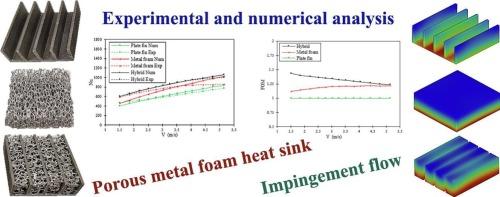冲击流下多孔金属泡沫对散热器影响的实验与数值分析
IF 5.4
3区 工程技术
Q2 ENERGY & FUELS
引用次数: 0
摘要
功率密度的提高和电子元件尺寸的缩小使得有效的热管理成为设计的一个重要方面。本研究采用实验和数值方法,在相同的冲击冷却条件下,对三种不同的散热器设计:板翅片、多孔金属泡沫和翅片金属泡沫混合散热器的热水力性能进行了独特的研究。本研究的创新之处在于,它使用局部热不平衡(LTNE)方法对这些设计进行了全面的评估,以精确模拟多孔材料内的传热。评估努塞尔数、压降等关键指标。研究结果表明,多孔散热器和混合散热器都优于传统的板翅设计,混合模型由于其更大的有效表面积和改善的流动中断而显示出最高的热效率。实验结果表明,在输入功率为30 W的情况下,采用金属泡沫混合散热器比采用板翅片散热器的平均努塞尔数分别提高了35.82%和24.79%,根据数值计算结果,这两个数值分别为34.76%和20.65%。这些结果为设计紧凑型电子设备的先进热管理系统提供了有价值的见解。性能指标(FOM)是通过同时考虑热性能和水力性能来确定的。与板翅结构相比,混合散热片和金属泡沫散热片的平均FOM分别提高了32.62%和19.47%。增加努塞尔数和增强的FOM在散热器导致提高传热效率和更好地保护电子元件免受热应力。研究了输入功率、界面面积密度和界面传热系数的影响。本文章由计算机程序翻译,如有差异,请以英文原文为准。

Experimental and numerical analysis of porous metal foam effect on heat sink under impingement flow
The rise in power density and the shrinking size of electronic components have made efficient thermal management an essential aspect of design. Present study uniquely explores the thermal and hydraulic performance of three different heat sink designs: plate-fin, porous metal foam, and hybrid of finned metal foam, using both experimental and numerical methods under the same impingement cooling conditions. The innovation of this study is its thorough evaluation of these designs using the Local Thermal Non-Equilibrium (LTNE) method to precisely simulate heat transfer within porous materials. Key metrics such as Nusselt number, and pressure drop were assessed. The findings reveal that both porous and hybrid heat sinks surpass the traditional plate-fin design, with the hybrid model showing the highest thermal efficiency due to its larger effective surface area and improved flow disruption. Experimental results indicate that utilizing a hybrid heat sink and metal foam at an input power of 30 W increases the average Nusselt number by 35.82 % and 24.79 %, respectively, compared to the plate-fin heat sink, which, according to the numerical results, these values are 34.76 % and 20.65 %, respectively. These results provide valuable insights for designing advanced thermal management systems for compact electronic devices. The Figure of Merit (FOM) is determined by simultaneously considering both thermal and hydraulic performance. the average FOM for the hybrid and metal foam heat sinks increases by 32.62 % and 19.47 %, respectively, relative to the plate-fin configuration. An increase in the Nusselt number and enhancement of the FOM in heat sinks lead to improved heat transfer efficiency and better protection of electronic components against thermal stress. The effects of input power, interfacial area density, and interfacial heat transfer coefficient are also examined.
求助全文
通过发布文献求助,成功后即可免费获取论文全文。
去求助
来源期刊

Thermal Science and Engineering Progress
Chemical Engineering-Fluid Flow and Transfer Processes
CiteScore
7.20
自引率
10.40%
发文量
327
审稿时长
41 days
期刊介绍:
Thermal Science and Engineering Progress (TSEP) publishes original, high-quality research articles that span activities ranging from fundamental scientific research and discussion of the more controversial thermodynamic theories, to developments in thermal engineering that are in many instances examples of the way scientists and engineers are addressing the challenges facing a growing population – smart cities and global warming – maximising thermodynamic efficiencies and minimising all heat losses. It is intended that these will be of current relevance and interest to industry, academia and other practitioners. It is evident that many specialised journals in thermal and, to some extent, in fluid disciplines tend to focus on topics that can be classified as fundamental in nature, or are ‘applied’ and near-market. Thermal Science and Engineering Progress will bridge the gap between these two areas, allowing authors to make an easy choice, should they or a journal editor feel that their papers are ‘out of scope’ when considering other journals. The range of topics covered by Thermal Science and Engineering Progress addresses the rapid rate of development being made in thermal transfer processes as they affect traditional fields, and important growth in the topical research areas of aerospace, thermal biological and medical systems, electronics and nano-technologies, renewable energy systems, food production (including agriculture), and the need to minimise man-made thermal impacts on climate change. Review articles on appropriate topics for TSEP are encouraged, although until TSEP is fully established, these will be limited in number. Before submitting such articles, please contact one of the Editors, or a member of the Editorial Advisory Board with an outline of your proposal and your expertise in the area of your review.
 求助内容:
求助内容: 应助结果提醒方式:
应助结果提醒方式:


